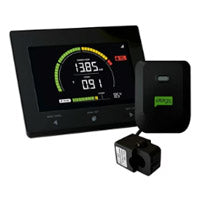The following energy monitoring devices offer the quickest and easiest way to understand electricity usage.
The product you need depends on what you want to find out:
- If you wish to monitor any plug-in appliance like a fridge or TV, use a Power Meter.
- Use an Energy Monitor to track an entire property, such as a home or small business.
- To measure something like a granny flat or EV charger, you'll need a Sub Meter.
Checking and measuring your electricity usage is surprisingly straightforward once you know how.
1. How to Measure the Electricity Usage of Appliances
A hairdryer, kettle, and mobile phone charger have one thing in common: a standard power plug. Using a plug-in power meter, you can measure anything with a 10-amp power plug.
You plug the power meter into an electrical outlet and then plug your appliance into it. It will show you a variety of informative readings including watts, kilowatt-hours, and cost.
We currently sell these plug-in power meters:
 |
Reduction Revolution Power Meter This low-cost option does the job for all ad-hoc monitoring around the home. It's our most popular choice thanks to its compact size and ease of use. |
 |
Smart Plug With Energy Monitor This is the product for you if you'd prefer an app-based solution rather than a physical display screen. The benefit of the smart plug is that it's not just for measuring - you can also switch appliances on and off. |
 |
The Power-Mate is a professional tool for energy auditors, electricians, and tech enthusiasts. Unlike our other power meters, it projects values into the future per hour, week, quarter and year for easy cost predictions. |
 |
Used only for measuring 15 amp appliances found in commercial kitchens, caravan parks, and elsewhere. 15A plugs are identifiable by their larger earth pin. |
 |
This power meter is an add-on to the Powersensor whole-home energy monitoring system - more on these below. |
 |
Add an extra sensor to an existing Powersensor system to monitor hard-wired appliances with accessible conduit (like air conditioners, pool pumps, and ovens). |
2. How to Check the Electricity Usage of a Home or Small Business
You'll soon realise that plug-in power meters miss some critical energy users that are 'hard-wired' or inaccessible, such as:
- Lighting,
- Air Conditioners,
- Ceiling Fans,
- Solar PV Panels,
- Outdoor Spas,
- Electric Hot Water Systems.
To track the electricity consumption of these items, you'll need to install an electricity usage monitor. Energy monitors give you a real-time display of your total power consumption. They are typically installed at your main electricity meter board.
We sell these wireless energy monitoring options:
3. How to Measure Electricity Consumption for On-billing (Or Similar)
Another issue you may encounter is the need to meter power usage in a particular area or for a large appliance. Use-cases include:
- Buildings like a granny flat, workshop or shed,
- Accommodation or tenancies like rooms, cabins, or sites,
- Large electrical loads like EV chargers, air conditioners, or hot water systems.
The good thing about these areas is that they usually have their own power circuit. This makes them an ideal candidate for an electrical sub-meter. An electrical sub-meter allows you to meter a circuit or group of circuits for the purpose of on-billing (or being better informed).
We offer two types of electricity sub-meters:
 |
MATelec Sub Meters (NMI Approved) These electricity sub-meters are NMI-approved, which means they are billing-grade. We recommend using these if you want a high-quality solution or if you will be using the data to on-bill a third party, such as a sub-tenant. They come in two sizes: |
 |
Our LANX sub-meters offer a more affordable solution that suits many users. Their accuracy is similar to the MATelec meters, without the formal NMI approval. They come in three size options: |
Still got questions?
Click here to browse our entire range of power meters, energy monitors and thermal cameras.

















